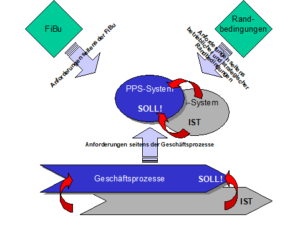by Dr. Wolfgang Stock, Michael Hugger1 and Dr. Götz-Andreas Kemmner
Before deciding on a new PPS system, you should pragmatically check whether reconfiguring the existing IT system in conjunction with a reorganization of order processing would not lead to a cheaper, more effective and faster PPS. The example of Orthomol GmbH in Langenfeld shows how you can pragmatically and systematically test the performance of a PPS system for the future needs of your company.
Orthomol is one of the leading companies in the orthomolecular medicine segment. The therapeutic principle of orthomolecular medicine is based on the knowledge that the human body requires over 40 vital substances – vitamins, minerals, trace elements and essential fatty acids – for the healthy, smooth functioning of all organs. In the right quantity and concentration, they offer optimum health protection. Orthomol develops and distributes such balanced doses of complex mixtures of natural micronutrients. Founded in 1991, the company was a perfect match for the population’s growing health awareness. Following dynamic growth, the company currently has 157 employees and continues to develop rapidly.
Only in the beginning was “little” enough
Orthomol uses the Rick PPS system from KEC Computersysteme GmbH in Eltville. Due to its ability to trace batches down to container level, Rick is primarily used in the pharmaceutical, chemical, cosmetics and food sectors. Orthomol operates Rick in a Novell network with NT clients. The use of Rick began with the sales module, followed by other modules. However, important modules for the planning function and parts list (recipe) management are still missing. With a dynamically growing business volume, it was clear to Orthomol that the existing implementation status of Rick would no longer be able to meet the future requirements of the market for fast and cost-effective order processing and delivery reliability. The company was therefore faced with the alternative of revising the existing PPS system or switching to a new PPS system. Orthomol drew on the experience of Abels & Kemmner to provide a reliable answer to this crucial question with major financial implications.
Keeping costs low with a pragmatic approach
The steps taken to check whether an existing PPS system still meets a company’s requirements are usually very different from the procedure for selecting a new system. If a review of the existing PPS system leads to the conclusion that it can no longer meet future requirements, considerable consulting costs have already been incurred that would not have been necessary if a new system had been selected directly.
In order to save costs and time, Abels & Kemmner’s approach was chosen so that the individual work steps could be used both for the selection of a new PPS system and for the evaluation of the existing system. If it had been concluded at the end of the project that the existing PPS system did not meet Orthomol’s future requirements, the project results could have been used directly for the pre-selection of a new PPS system.
Starting point: future order processing

The project approach (see Fig. 1) was based on the realization that the business processes running in the company are generally not designed in a way that would make sense from a business and organizational perspective. For this reason, after recording the current business processes, a framework concept for the future design of order processing and production organization was jointly developed. Requirements for a future PPS system were defined on the basis of this framework concept. Other key requirements for a future PPS system resulted from the interface between PPS and financial accounting and from operational and strategic constraints such as requirements for the software provider and the software as well as strategic corporate developments that must be taken into account in a future PPS system.
Requirements profile and “sticking points” list
The future PPS requirements profile was mapped in a list of “sticking points” and translated into a detailed catalog of requirements based on the PPS market survey of the Research Institute for Rationalization (FIR). While the “sticking points” list dealt with the acute problems of the users in relation to the PPS, the requirements catalog mapped the entire future functional requirements for a PPS system. The analysis of the current situation showed that order entry was currently still coping well with the existing IT support. Purchasing, on the other hand, had the greatest difficulties, which were mainly organizational and could only be solved through better system support. Requirements catalogs are almost always misunderstood as “wish lists” by the employees involved in defining the requirements. The result is an exaggerated requirements profile with numerous knock-out criteria that can only be met by the most comprehensive systems available on the market. To avoid this trap, the consultants from Abels & Kemmner defined Orthomol’s current and future requirements based on the analyses carried out. This pragmatic approach saved time and made it unnecessary for Orthomol’s project staff to have to deal with abstract technical terminology. The requirements defined by the consultants were far-reaching, but deliberately refrained from differentiating between can, must and knock-out criteria.
PPS system in the shortage
In a two-day workshop with the PPS provider, the consultants and selected members of the project team, the “sticking points” list and the requirements profile were discussed. More complex issues were understood using the IT system. The workshop showed that the majority of the requirements formulated were met or even exceeded by the Rick system. Only the importance of the requirement criteria that Rick could not fulfill was discussed in the project team. In addition to uncritical can-do demands, there were also some serious demands. Either organizational solutions were developed or program additions were defined. With a suitable organizational concept, Orthomol’s requirements for the phase-in of new products and phase-out of discontinued products, for example, can be met with the functionality available in Rick. However, Rick’s functionality must be supported by add-on systems in the area of sales forecasting and, in the medium term, in the optimization of material planning.
Decided to optimize the PPS
After a cost estimate between the revision of the existing PPS system and the introduction of a new PPS system showed a clear cost advantage for the existing system, the project team came to the decision to stick with the Rick system and to optimize order processing and the IT system. A joint project team from Orthomol, Abels & Kemmner and the system provider is currently working on this task. The aim is to go live with the completely restructured PPS from July 1, 2001. Orthomol is thus equipped for further dynamic growth.
1 Dr. rer. nat. Wolfgang Stock is Technical Managing Director, Dipl.-Ing. Michael Hugger is Head of IT at Orthomol GmbH in Langenfeld.

